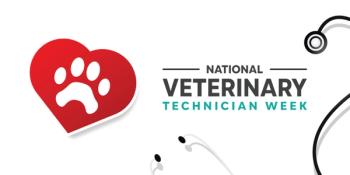
- dvm360 August 2024
- Volume 55
- Issue 8
- Pages: 34
Award winners show why hospital design matters
The 2024 Hospital Design360 Competition honors 3 grand prize winners and 7 merit award winners
Three veterinary hospitals have been named grand prize winners in dvm360’s 2024 Hospital Design360 Competition. These newly built or recently renovated facilities were each named Hospital of the Year in 3 structure size categories, and 7 more hospitals are receiving merit awards. All winners are being recognized for the quality and uniqueness of their layouts, decor, and amenities, as well as spaces that serve staff, clients, and patients well.
“With the highest number of submissions this year, these 3 winners did a fantastic job showcasing their outstanding veterinary hospital designs, setting a new benchmark for excellence in our profession,” said Adam Christman, DVM, MBA, chief veterinary officer for dvm360. “Their arduous work, dedication, and passion for innovation are celebrated in each of these outstanding hospitals.”
The 3 grand prize winners will be presented with their awards on August 25, 2024, with a celebratory luncheon during the Fetch dvm360 conference in Kansas City, Missouri. The event will also feature a panel discussion with the winning practice owners, as well as an architect and design expert.
dvm360’s John Hydrusko, vice president of sales at MJH Life Sciences, congratulated all the competition winners in a statement. “We are honored to add these incredible clinics into our Hospital Design winner’s circle. Creating a beautiful workspace for employees, clients, and pets they service is a true testament to exceptional veterinary care,” he said.
Larger than 8000 sq ft winner
Blue Cross Animal Clinic
According to Ashlee Andrews, DVM, owner of Blue Cross Animal Clinic in Albuquerque, New Mexico, people do not like to drive far for veterinary appointments. So, in scouting the location for the first veterinary hospital she will be building from the ground up, after touring old banks and churches, she purchased a lot that was 3 minutes from her current hospital and began building Blue Cross Animal Clinic.
For Andrews, building a new clinic for her team, patients, and staff was needed. Their then 7-member veterinarian team had outgrown the previous space, so they ventured out to build one that would fit everyone, give the staff space they needed to both decompress and work, and provide a beautiful addition to the city of Albuquerque. However, the team began to face unexpected challenges before building the hospital, as they bought the lot right before the COVID-19 pandemic started.
“We just sat on [the lot] for a while because we didn’t know what was going to happen; there were supply chain issues and people weren’t working,” Andrews said. “Then [further] into [COVID-19], we had to completely change our price schedule because everything got more expensive during [the pandemic], and then [we had to] work to find staff and laborers [who] were working, so that delayed [us].”
Because she had previously only done renovations before this clinic, another unexpected challenge the hospital faced was making big decisions without seeing the space, such as deciding how many outlets the clinic would need and where things would be placed within examination rooms and common areas. Andrews said they were lucky because they worked with architects and builders who only worked in veterinary clinics, so they provided the guidance she needed to make her dream hospital come to life.
The new hospital itself features multiple unique features to benefit all those who enter. The team designed the facility’s quiet/relaxation room outside the larger break room that has calm lighting, puzzles, coloring books, and a small fountain to serve as a retreat for staff who need a breather from the chaos of a veterinary hospital. The front desk has enough room for 2 client service representatives to greet clients and immediately bring them to 1 of 12 exam rooms to minimize contact between patients and to minimize noise from the lobby. Andrews also explained that they designed the hallways within the clinic to prevent animals from being on top of each other when they are coming and going from the exam rooms. For Andrews, her favorite feature within the hospital is the “doctor fishbowl.”
“[The fishbowl] is a charting area for our techs and doctors in the middle of the treatment area. It has glass walls on every side and doors we can close. You can see the whole treatment area. You can see patients being induced. You can see dentals happening. You can see [patients] going into surgery, but it’s still quiet, so you can call owners to get your charts done. But if there’s a problem, you can see it, or the staff can wave at you. That’s something I’d seen at a previous hospital I worked at years ago—actually in a different country—and wanted to incorporate into our building,” Andrews said.
Andrews also shared that within the hospital, she is most proud of the space itself. The colors they used to decorate and the natural light are some things she takes pride in, as well as the euthanasia rooms. Within the hospital, the euthanasia room serves as a quiet place where clients can peacefully say goodbye and then use a separate exit so they do not have to walk through the lobby.
Through the design of the hospital, Andrews created a place for her community to take their pets and know they are getting excellent care in a safe space that meets the needs of its staff, patients, and clients, especially for those who did not want to have to travel farther than normal to them.
“[The community was] really excited. In the beginning, there was a lot of commentary about [it being] 3 minutes further away…[then] people saw that there was adequate parking and that the building was more spacious the way we’ve designed it. Clients are also roomed right away, so we don’t have a huge lobby. They come in and they’re immediately put into an exam room, [which] reduces the stress on the pet, it reduces the noise, [and] it reduces clients hearing other people’s business in the lobby. So, once clients came in, they were really impressed and have really seemed to enjoy it,” Andrews said.
3500 to 8000 Sq Ft winner
Habitat Veterinary Hospital
Nearly 2 decades ago, a new space dedicated to creating a culture and environment where both pets and people could thrive would come to fruition. Aiming to defy the traditional design aesthetics of veterinary hospitals, Sohaila Maleki, DVM, and her husband, Reed Linenberger, DVM, set out to build a new practice that would bring peace and calm to its patients, clients, and staff through natural elements. This dream gave birth to Habitat Veterinary Hospital, an Idaho-based and independent veterinary hospital with locations in Ketchum and Boise—the latter of which is the 2024 winner of the 3500 to 8000 sq ft category for the Hospital Design360 Competition.
“Seventeen years ago, we reached this point where we were contemplating starting our own practice because we just couldn’t find a practice that we wanted to be a part of. All the practices sort of followed…these old elements of veterinary medicine, and the environment of the practice…wasn’t something that seemed to be really highlighted,” Maleki said in an interview with dvm360.
“We wanted [our practice] to be a place where pets and their people could come, and they would have everything they needed to not only survive but [also] thrive. For us, that was really important. Creating that sense of peace and calm with all the natural elements was very important because…that always brought a sense of grounding for us, so to bring that into our workplace was crucial for us,” she said.
Habitat Boise blends nature with its practice and the care it offers, with its giant windows, lively green walls and foliage throughout the reception and lobby area, outdoor exam rooms, an outdoor private patio and garden for its staff, and a location next to the Boise River. Its integration with the outdoors allows its clients and team alike to connect with the natural world, which is a vital option when staff and/or clients are facing difficult or high-stress moments.
Outdoor exam rooms
The hospital’s outdoor exam room and gardens are accessible from the indoor exam rooms and from the parking lot, providing flexibility in how animals can enter the hospital. This setup aims to provide patients with a sense of peace by allowing them to freely move between indoor and outdoor spaces during their visit. “When a patient comes in and is nervous, sometimes just being able to be outside with them while doing our exam helps bring a sense of calm,” Maleki said.
Linenberger highlighted the positive effect the outdoor exam rooms have on the pet owners. “When they’re really stressed out, that sense of grounding…is important. They can…go outside and just take a deep breath [and] think about what’s happening,” he told dvm360.
“It also gives some opportunity for families…. If there’s a euthanasia happening and we want to make it a really calm, peaceful, and natural setting, we just lay a blanket outside, and we all go outside and it provides a less clinical [and] less formal setting,” Maleki said.
Break rooms and wellness
The hospital’s design, which was a collaboration with MD Architects, formerly known as Architectural Werks, also implemented an outdoor private patio and garden with a hammock for its team members, offering a calm retreat that supports relaxation and provides access to fresh air, which contributes to promoting their mental well-being while also providing an opportunity to socialize and strengthen team cohesion.
“For us, it’s a center to bring people together and [encourage] collaboration and connection,” Linenberger said. “[There’s] a big door that goes into a beautiful kitchen, and then a door that goes out to a garden…. When our team is having a particularly stressful day, they have a place to relax [and] take a minute for themselves.”
The building also has showers available for its staff, which encourages lunchtime physical activity and outdoor breaks, according to the owners.
Location
The proximity to the Boise River and a greenbelt allows clients to access the hospital on foot and encourages the team to go for a walk on the greenbelt during breaks. “We also chose our location right on the Boise River because we wanted it to have really natural elements in our surroundings,” Maleki said. According to the couple, Habitat’s location also allows it to actively participate in community river cleanups and serve as stewards for Loggers Pond.
Integrating with Boise location’s natural, calming design, Maleki and Linenberger explained that their mission is to conserve the essence of veterinary medicine. “We really want to be a leader in not only creating that culture where people and pets thrive, but also [in] the industry, where we can say we’re working to help preserve the heart and soul of veterinary medicine. Because with…corporations taking over, we’re losing that peace. We’re losing that heart and soul of what makes veterinary medicine so special,” Maleki said. “I really want to help inspire other smaller ‘mom-and-pop’ practices out there to just keep going and to remember why we all started in this profession in the first place.”
Smaller than 3500 Sq Ft winner
Vet Vision Center
Shelby Reinstein, DVM, MS, DACVO, owner and founder of Vet Vision Center, spent a decade working in a large, multispecialty, corporate practice as chief of the ophthalmology service. When she was ready to start creating the small specialty hospital of her dreams, she drew inspiration from educational lectures about hospital design that she had attended during a virtual Fetch dvm360 conference.
Notably, Reinstein recalled hearing Wayne Usiak, AIA, NCARB, founder of BDA Architecture, which specializes in animal health facilities, speak about the types of properties that are ideal for renovating a veterinary clinic. The talk made an impression on the veterinary ophthalmologist who had been unsure, at that point, of whether to build her hospital with new construction or through renovation.
“That’s one of the first things I was trying to figure out. I remember him saying that if you’re going to renovate a space, you need to keep in mind the infrastructure, the [electrical] power, and the water capacity. [Specifically], he said things like, ‘Restaurants make great veterinary hospitals because they have the power supply,’” Reinstein said in an interview with dvm360.
Expanding her search for a property to include those parameters led Reinstein to a former diner in Lawrenceville, New Jersey. In addition to having power and water already in place, the property offered a generous parking space and a clearly defined entrance.
A landmark in Lambertville, the property has been a local focal point since the 1950s, and Reinstein said she wanted to use that sentiment to connect with her new community. While making cosmetic upgrades to the exterior, she and the team she worked with at Apex Design Build paid great attention to maintaining the structure’s existing style and made sure it was incorporated into the final aesthetic.
However, her plans for her dream hospital weren’t limited to infrastructure and the building’s history but extended to elevated and modern design concepts. “I wanted the Vet Vision Center to not only stand out as a specialty clinic but [also] be an example of how innovation in design can mesh with compassionate medicine to create a thriving business and a great place to work,” Reinstein wrote in her competition application.
As an ophthalmology-focused hospital, the design of the patient care spaces considered lighting choices for examination spaces. For example, cove ceilings help implement lighting that works well for examining patients’ eyes. “I knew I wanted lighting that was not directly above my patient, [which] makes the exam process better because you have completely dark space right around the animal,” Reinstein said, who also included red lighting in her plans.
Additionally, transom windows were placed strategically throughout the space to allow more natural light to flow in. She also kept the exterior windows that had been an iconic feature of the former diner. “I put a transom window into my primary my practice manager’s office and everywhere [else] I could put a window. If there was a wall and it could handle the window, I put one in because I wanted the connection of this space [to other spaces. You] can see out to the nurses station…[and] into sterilization,” Reinstein said.
Reinstein said she wanted a lot of natural light because it has a known positive effect on happiness for both humans and animals. “There are a lot of studies that show that certain light—for example, big tube lighting that people have overhead, and halogen light— flickers at a frequency that some dogs can perceive. It’s kind of a strobe light for dogs. So, [we are] understanding and trying to incorporate Fear Free concepts [to create] peace and tranquility. Natural light has been shown to reduce heart rate, cortisol [levels, and] stress hormone levels, [as well as] improve the rate of healing,” she said. “There were benefits for the people [who] work here, as well as the patients and the people attached to the patients.”
Although the abundance of natural light and inclusion of large windows offering views of the neighboring trees brought the outdoors inside, Reinstein also brought the indoors outside. An existing patio was used to create a fenced-in extension of the lobby that allows patients and clients to wait in a calming and safe environment. The inclusion of live greenery and a water fountain help to reduce auditory and visual stimuli, Reinstein said.
Indoors, the lobby captures Reinstein’s vision of providing a spa-like atmosphere with coffeehouse and minimalist aesthetics. A snack and beverage station and a layout that allows for species separation further elevates the reception area’s comfort and client experience, according to Reinstein.
The renovation of the former diner also allowed Vet Vision Center to use more environmentally friendly elements. When the heating and cooling system needed replacement, Reinstein had an energy-efficient system installed. Furthermore, many materials used were chosen for sustainability, such as solid surface countertops that last longer than laminate, recycled clay tile, and use of recyclable vinyl decals instead of paint.
Articles in this issue
about 1 year ago
Sharing stories of compassion on the West Coastabout 1 year ago
Meet the 2024 Hospital Design 360 Competition Merit Winnersabout 1 year ago
Equine head wounds and skull fracturesabout 1 year ago
Converting callers into clientsabout 1 year ago
Life lessons from a US Army Veterinary Corps veteranabout 1 year ago
Designing for low-cost community veterinary servicesabout 1 year ago
Social media: friend or foe?over 1 year ago
RECOVER Initiative announces updates to CPR guidelinesNewsletter
From exam room tips to practice management insights, get trusted veterinary news delivered straight to your inbox—subscribe to dvm360.






